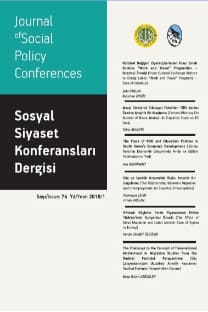Global Cities and The Future of Demographic Transformation
Global Cities and The Future of Demographic Transformation
The structural transformation adventure of urbanization in global cities is always closely linked to economic development. Today, thanks to the demographic transformation that includes this economic situation, migrants have started to spread to small and medium-sized cities and global cities with less capacity and resources. In this process, the attitude of city administrations can balance the demographic change that occurs and the opportunities and costs that may be created by a wave of immigration. At the same time, it is important for cities to be prepared for possible situations by having future plans in place, to shape the future of both cities and their demographic structure in a positive sense. Although national legislation can regulate cross-border migration, concepts that can reveal the effects of migration on cities are needed. Among these, countries with weaknesses in areas such as city planning, financing and management, land allocation, housing supply, and basic services fall short of controlling migration flow and demographic planning. In addition, population changes that change and shape the demographic structure of cities on a global scale should be handled within this framework. Planning to be made on a global scale and with a holistic perspective will help each city shape its expectations about its future visually
___
- Andrea Tobia Zevi (Ed). The Century of Global Cities. How Urbanisation Is Changing the World and Shaping our Future Edited by First edition: December 2019
- Catherine Dauvergne, Making People Illegal What Globalization Means for Migration and Law, Cambridge University Press, 2008
- Cheng, Congjun. “A study of Dynamic Econometric Relationship Between Urbanization and Service Industries Growth in China”, Journal of Industrial Engineering and Management JIEM, 2012 – 6(1): 8-15 – Online ISSN: 2013-0953 – Print ISSN: 2013- 8423 http://dx.doi.org/10.3926/jiem.657
- DEMOGRAPHIA WORLD URBAN AREAS 13th ANNUAL EDITION April 2017, http://demographia.com/db-worldua.pdf, (22 May 2017)
- Dudley Kirk, “Demographic Transition Theory”, Population Studies, 50 (1996), 361-387, http://shrinking.ums-riate.fr/Ressources/Chap_01/KIR_96.pdf (22 March 2019)
- Emily Moir, Tim Moonen ve Greg Clark, “The future of cities: what is the global agenda?”, The Business of Cities, 2014
- Gérard-François Dumont,” Urban demographic transition”Urban development issues, 2018, https://halshs.archives-ouvertes.fr/halshs-01781454/document (13 March 2020)
- Göç İdaresi Genel Müdürlüğü,http://www.goc.gov.tr/icerik3/gecici-koruma_363_378_4713 ,(20 December 2019).
- International Labour Organization, World Employment and Social Outlook: Trends 2017,
- Geneva, 2017, http://embargo.ilo.org/wcmsp5/groups/public/---dgreports/---dcomm/- --publ/documents/publication/wcms_541211.pdf, (15 May 2017)
- J. A. Scholte, The Globalization of World Politics, J. Baylis and S. Smith (editörler), The
- Globalization of World Politics, An Introduction to International Relations, New York: Oxford University Press, 1999.
- Jean-Claude Garcia-Zamor, Ethical Dilemmas of Migration, Springer International Publishing, 2018, John Eade, “Cultural and Ethnic Diversity in Cities: Challenges and Chances”, Networking
- European Citizenship Education, 24-26 June 2010 in Barcelona, Spain México en Cifras, http://www.beta.inegi.org.mx/app/areasgeograficas/?ag=15, (13 March 2020).
- New York Population 2019, http://worldpopulationreview.com/states/new-york-population/, (12 March 2019).
- Notestein, Frank W. 1953: Economic Problems of Population Change. In: Proceedings of the Eighth International Conference of Agricultural Economists, New York. 13-31.
- Nigel Harris, Urbanization, Economic Development And Policy In Developing Countries, 1990.
- UN Member States, http://www.un.org/en/member-states/, (5 May 2020).
- Peter Hall, “Urban Land, Housing, And Transportation: The Global Challenge”, Global
- Urban Development Magazine , Volume 3, Issue 1, November 2007, https://www. globalurban.org/GUDMag07Vol3Iss1/Hall.htm, (20 December 2020).
- Pew Research Center, Total Fertility Rate by Religion, Projected From 2010-2050, 2015, http://www.pewforum.org/2015/04/02/main-factors-driving-population-growth/ pf_15-04-02_ch1graphics_fertilityreligion640px/, (15 May 2017).
- Pew Research Center, Total Fertility Worldwide, 1950-2050, 2015 http://www.pewforum. org/2015/04/02/main-factors-driving-population-growth/pf_15-04-02_ch1graphics_ fertilityrateworldwide310px/, (15 May 2017).
- Pew Research Center, Average Life Expectancy at Birth, 1950-2050, 2015 http://www. pewforum.org/2015/04/02/main-factors-driving-population-growth/pf_15-04-02_ ch1graphics_lifeexpectancy310px/, (17 May 2017).
- Race and Ethnicity in New York, https://statisticalatlas.com/place/New-York/New-York/
- Race-and-Ethnicity, (12 March 2019).
- Raco, M.; Kesten, J. Urban Studies, “The Politicisation of Diversity Planning in a Global
- City: Lessons from London”, ScholarOne Manuscripts, 2016, http://discovery.ucl. ac.uk/1517942/1/PDF_Proof%20%283%29.pdf, (20 November 2020).
- Richard Sennet, Ten ve Taş Batı Uygarlığında Beden ve Şehir, Tuncay Birkan (translated) İstanbul: Metis Yayınları, 3rd Edition, 2002.
- Robin Hambleton ve Jill Simone Gross, Governing Cities in a Global Era Urban Innovation, Competition, and Democratic Reform, New York: Palgrave Macmillan, 2007.
- Ronald D. Lee David S. Reher, Demographic Transition and Its Consequences, New York: Population and Development Review, 2011.
- The Statistics Portal, https://www.statista.com/statistics/270860/urbanization-bycontinent/,(13 March 2020).
- The World Bank, http://data.worldbank.org/indicator/SM.POP.REFG (13 March 2017).
- Tokyo’s History, Geography and Population, http://www.metro.tokyo.jp/ENGLISH/ ABOUT/HISTORY/history03.htm, (13 March 2020).
- UN The World’s Cities in 2018, Population distribution by size class of settlement* and region, 2018 and 2030, https://www.un.org/en/events/citiesday/assets/pdf/the_worlds_ cities_in_2018_data_booklet.pdf , (10 September 2020).
- United Nations Department of Economic and Social Affairs Population Division, Urban Agglomerations 2014, 2014, http://esa.un.org/unpd/wup/Wallcharts/WUP_2014%20
- Urban%20Agglomerations%20Wallchart.pdf (15 September 2020).
- United Nations, World Urbanization Prospects The 2014 Revision, New York, 2015, http://esa.un.org/unpd/wup/Publications/Files/WUP2014-Report.pdf, (15 September 2020).
- United Nations, 2017 Revision of World Population Prospects, New York, 2017, https:// esa.un.org/unpd/wpp/Publications/Files/WPP2017_KeyFindings.pdf, (15 May 2017).
- UNCHR Statistics The World in Numbers, http://popstats.unhcr.org/en/overview (15 July 2020).
- UNFPA, State of World Population 2007 Unleashing the Potential of Urban Growth, 2007, https://www.unfpa.org/sites/default/files/pub-pdf/695_filename_sowp2007_eng.pdf, (03 September 2021), p.7
- World Population Review Mumbai,http://worldpopulationreview.com/world-cities/ mumbai-population/, (13 March 2020).
- World Population Review Guangzhou, http://worldpopulationreview.com/world-cities/ guangzhou-population/, (13 March 2020).
- ISSN: 1304-0103
- Yayın Aralığı: 2
- Başlangıç: 1948
- Yayıncı: İstanbul Üniversitesi Yayınevi
